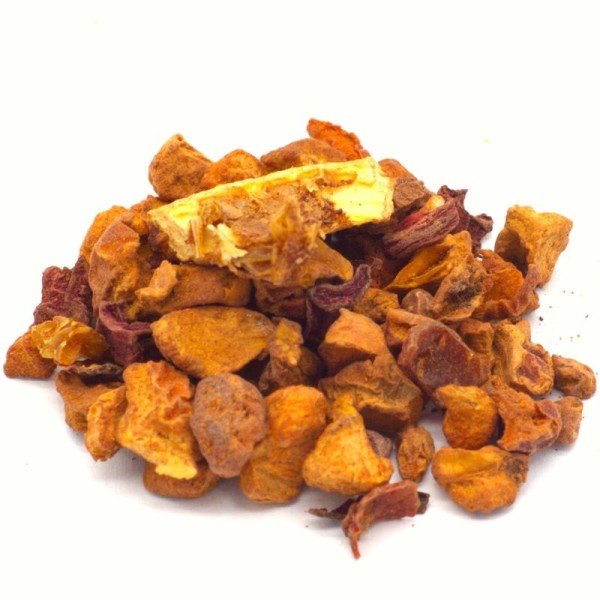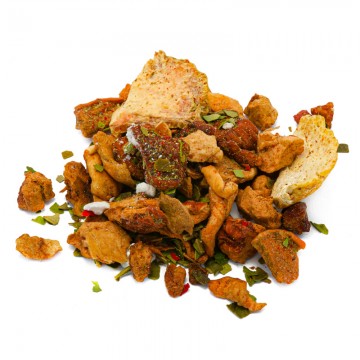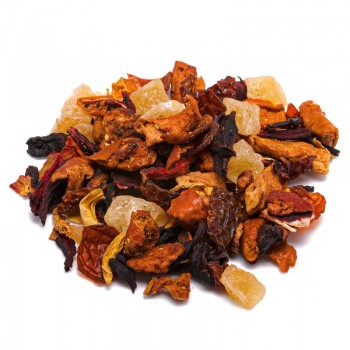Savoring this infusion means having a unique taste experience, in the fruity and slightly spicy blend, with sweet notes of cocoa. The drink is perfect in the morning and for dessert, but it can be enjoyed on any occasion when you want an intense and sweet flavour, with notes of orange and citrus. The orange peel and pieces of the fruit combine with the beans and cocoa extracts, enhanced by the intense nuances of rosehip, hibiscus, apple and mandarin; until the final sweetness of vanilla.
Orange and cocoa infusion: properties and benefits
Different elements of the herbal tea help the digestive function, thanks to the qualities of the orange peels, the pieces of orange and the apple.
Up to the chicory roots, which similarly to orange they contain stimulating substances for gastrointestinal well-being, promoting the growth of beneficial bacterial flora in the intestine. These functions of the various ingredients help in case of constipation, for the regularity of intestinal transit and avoid the formation of intestinal gas. The infusion also acts as a stimulus to the drainage of body fluids, facilitating diuresis.
The orange and cocoa infusion also represents a drink rich in energy, giving small doses of caffeine and theobromine which promote concentration and vitality. The tonic and energizing effect is also supported by magnesium, and the infusion becomes a small opportunity for good mood during the day.
Orange makes vitamin C available (also present in rosehip and hibiscus), and other antioxidants useful for our well-being and metabolic support.
Origins and history of cultivation
The orange tree is a tree known since ancient times, and its presence has been attested for centuries in China, where it probably developed around 4000 years ago. The botanical origin of this citrus fruit is uncertain, but presumably it was a natural hybrid derived from the bitter orange or from the cross between the mandarin and the pomelo.
The most cultivated version is the sweet orange, widespread in many parts of the world because the plant easily adapts to various environmental conditions.
Through commercial traffic it reached Asia Minor first from China, then Egypt, North Africa and finally Europe. For many centuries it has been a fruit symbol of love and fertility, and in fact orange blossoms represent a good omen for marriage. The cultivation of sweet orange in Italy began in the Renaissance, in the regions of Sicily and Calabria, introduced by the Portuguese - in many dialects the orange was called "Portugal".
This mixture offers as a second ingredient, cocoa in different forms including cocoa beans, cocoa powder and cocoa extract. The seeds, i.e. cocoa beans, represent the heart of the Theobroma Cacao plant, native to South America - in the rainforests.
Already used by local natives many centuries ago, during the pre-Columbian civilizations of the Maya and Aztecs, they were considered sacred – broad beans were described as “food of the gods”. They are essential for obtaining cocoa, cocoa butter and chocolate, through the processing of raw cocoa beans. They can be consumed in their pure state, highly sought after for their beneficial qualities.
Raw cocoa beans are much more often subjected to different levels of processing. Both with simple fermentation and drying, which leads to raw cocoa beans, and with further processing such as roasting or roasting and grinding - for cocoa powder. Different processes, based on the food products you want to obtain. Cocoa beans are a fundamental ingredient for the preparation of chocolate.
Plants and flowers
The tree that produces sweet oranges is Citrus sinensis, which is part of the Rutaceae family. The orange fruits of this Dulcis variety are distinguished from bitter oranges (Citrus aurantium var. amara). Citrus sinensis can reach about 12 meters, showing elongated leaves and white flowers. The round, orange fruits, with rough skin, are often abundant in the harvest. Over the centuries, many varieties of orange have been cultivated and developed, which produce oranges for the table, for squeezing, for the production of juices, candied fruit and dried oranges.
Cocoa derives from the tropical plant Theobroma cacao, belonging to the Malvaceae family. It is an evergreen that grows in the equatorial territory, thanks to the hot and very humid climate. After four years the cocoa tree produces fruit, elongated pods, called cabosses. They have an elongated shape and a whitish, sweet pulp – the cocoa beans are found there, inside the fruits. Each pod contains 20 to 60 oval seedsi, also called cocoa beans.
The Malus domestica of the Rosaceae family is the plant that produces apples. The tree is native to Asia, now widespread throughout the planet in many varieties. The fruits vary in colour, size and consistency of the pulp, collected and consumed in human food for millennia.
Vanilla comes from the climber Vanilla planifolia, and belongs to the Orchidaceae family. It displays numerous flowers, from creamy white to pale green. The fruit is a long capsule from which seeds and vanilla flavor are extracted. They derive from various types of orchids including Polynesian Vanilla x-tahitensis and Bourbon Vanilla.
The rosehip is the false fruit of some species of rose, a perennial plant of the Rosaceae family. It often derives from the Rosa Canina but also from the Rugosa, Acicularis or Cinnamomea species. There are thousands of rose cultivars, in the form of upright or climbing shrubs, and most derive from Asia. The flowers change shape, size and color, while the rosehip appears oval, fleshy and red. Rose hips represent the mature ovary that remains on the branch after the flower, and inside they contain about 3 small seeds.
The hibiscus plant, Hibiscus sabdariffa, belongs to the Malvaceae family. It grows in tropical and subtropical regions, and is used in its different parts. The calyx and flowers are used for hibiscus tea, as well as for creating flavors and colorings.
Beetroot is Beta vulgaris, a plant of the Amaranthaceae family. A fast growing vegetable, easily grown everywhere. There are many edible parts, and the roots are used in infusions - the best known are the red beetroot varieties, but there are golden and streaked ones.
The mandarin Citrus reticulata is a tree belonging to the Rutaceae family. The tree is not very large with thin twigs and shiny evergreen leaves. When flowering, fragrant white flowers appear, followed by the fruit, sweeter and less acidic than normal oranges.
The chicory plant is Cichorium intybus and is a perennial herbaceous plant of the Asteraceae family. Produces erect stems, leaves known for food consumption, light blue flowers (sometimes pink or white). It shows a large fleshy root, which exudes a milky sap when cut, known as a coffee substitute or seasoning for gravies and sauces.
Nutritional values of the orange and cocoa infusion
The ingredients make mineral salts such as calcium, potassium, iron and magnesium available in the infusion. Contains substances such as caffeine, theobromine, polyphenols, tannins.
How to use the ingredients in the infusion
The infusion is obtained by placing approximately 3-5 grams in a cup (250 ml) the mixture of orange and cocoa with water at a temperature of approximately 100 °C.
Leave to infuse for 10 to 12 minutes before drinking. Add honey or sugar, if desired.
Orange and cocoa infusion: side effects and contraindications
To avoid unwanted effects, it is necessary not to exceed the doses. Excessive consumption may cause headache, nausea, abdominal bloating, insomnia or agitation due to caffeine and theobromine. Caution is advised for pregnant and breastfeeding women.











 No reward points for this product.
No reward points for this product.















